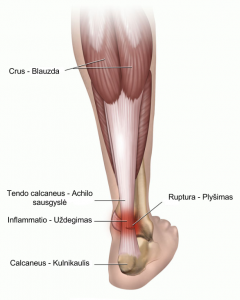Achilles tendinitis, also known as achilles tendinopathy, occurs when the Achilles tendon, found at the back of the ankle, becomes inflamed. The most common symptoms are pain and swelling around the affected tendon. The pain is typically worse at the start of exercise and decreases thereafter. Stiffness of the ankle may also be present. Onset is generally gradual.
It commonly occurs as a result of overuse such as running. Other risk factors include trauma, a lifestyle that includes little exercise, high-heel shoes, rheumatoid arthritis, and medications of the fluoroquinolone or steroid class. Diagnosis is generally based on symptoms and examination.
There are several simple actions that individuals can take to prevent or reduce tendinitis. Though commonly used, some of these actions have limited or no scientific evidence to support them, namely pre-exercise stretching. Strengthening calf muscles, avoiding over-training, and selecting more appropriate footwear are more well-regarded options.
Running mechanics can be improved with simple exercises that will help runners avoid achilles injury. Treatment typically involves rest, ice, non-steroidal antiinflammatory agents (NSAIDs), and physical therapy. A heel lift or orthotics may also be helpful. In those whose symptoms last more than six months despite other treatments, surgery may be considered. Achilles tendinitis is relatively common.


